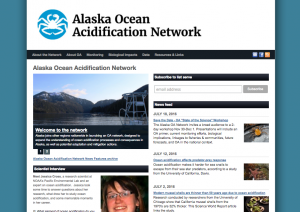
Click to enlarge
The website is designed to be a comprehensive source of information for ocean acidification in Alaska. The site includes information on monitoring projects around the state, current trends and forecasts, impacts to Alaska marine life, links to databases and journal articles, and a listing of experts and their specialties.
This week marks the launch of the Alaska Ocean Acidification Network, an initiative designed to expand the understanding of ocean acidification processes and consequences in Alaska, as well as potential adaptation and mitigation actions. The network is the fourth regional ocean acidification network in the US, and will help connect scientists and stakeholder communities, recommend regional priorities, share data, and determine best practices for monitoring.
Ocean acidification has become an increasing concern for Alaska. Scientists estimate that the ocean is 25% more acidic today than it was 300 years ago, largely due to increasing levels of atmospheric carbon dioxide (CO2) from fossil fuels and changes in land use. Almost half of the CO2 emitted remains in the atmosphere, with the land and ocean absorbing the rest. When the ocean absorbs CO2, its pH balance changes through a process called ocean acidification. Because cold water can absorb more CO2 than warm water, acidification can disproportionately impact coastal regions around Alaska.
Among the roles of the network is hosting a comprehensive website with resources for both researchers and the general public. The site includes information on monitoring projects around the state, current trends and forecasts, impacts to Alaska marine life, links to databases and journal articles, and a listing of experts and their specialties.
“As the issue has grown, there has been a clear need for a central place to learn more – specifically as it relates to Alaska,” said Darcy Dugan of the Alaska Ocean Observing System and coordinator of the network. “People like to know what’s going on in their backyard, and have the opportunity to ask questions directly to the experts.” Other network activities include facilitating researchers to speak at venues around the state, hosting webinars, convening scientists to coordinate on research, and holding a “State of the Science” workshop this winter.
“We’re excited to be partners in the network,” said Jeff Hetrick, director of the Alutiiq Pride Shellfish Hatchery in Seward. “Having a place to gather and share information helps facilitate relationships with all of the moving parts in the OA field, and allows us to keep up with the latest science”.
The network is coordinated by the Alaska Ocean Observing System, with participation from government agencies, research institutions, non-profits, industry, and local communities. For questions, contact network coordinator Darcy Dugan, dugan@aoos.org.
